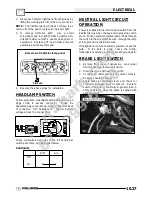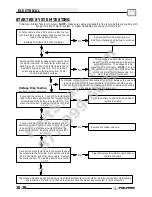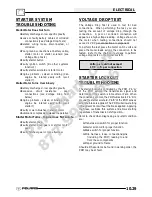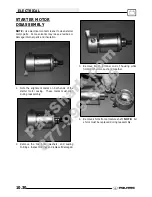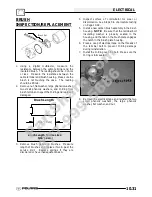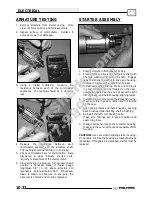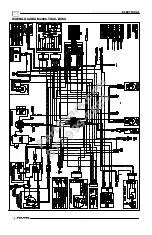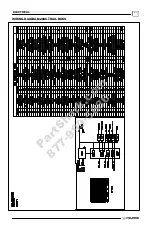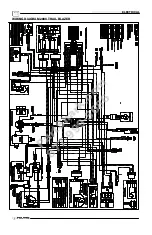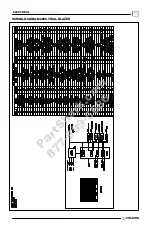
ELECTRICAL
10.24
CONVENTIONAL BATTERY
OCV - OPEN CIRCUIT
VOLTAGE TEST
Battery voltage should be checked with a digital
multitester. Readings of 12.6 volts or less require
further battery testing and charging. See charts and
Load Test on below.
NOTE: Lead-acid batteries should be kept at or near
a full charge as possible. Electrolyte level should be
kept between the low and full marks. If the battery is
stored or used in a partially charged condition, or with
low electrolyte levels, hard crystal sulfation will form
on the plates, reducing the efficiency and service life
of the battery.
CONVENTIONAL BATTERY
SPECIFIC GRAVITY TEST
A tool such as a Battery Hydrometer (PN 2870836)
can be used to measure electrolyte strength or
specific gravity.
As the battery goes through the
charge/discharge cycle, the electrolyte goes from a
heavy (more acidic) state at full charge to a light (more
water) state when discharged. The hydrometer can
measure state of charge and differences between
cells in a multi-cell battery.
Readings of 1.270 or
greater should be observed in a fully charged battery.
Differences of more than .025 between the lowest and
highest cell readings indicate a need to replace the
battery.
Detail A
1.10
1.15
1.20
1.25
1.30
Battery Hydrometer (PN 2870836)
Continued on next page
OPEN CIRCUIT VOLTAGE
State of
charge
Conventional
Lead-acid
100%
Charged
75% Charged
50% Charged
25% Charged
0% Charged
12.60V
12.40V
12.10V
11.90V
less than 11.80V
SPECIFIC GRAVITY
State of
charge*
Conventional
lead-acid
100%
Charged
75% Charged
50% Charged
25% Charged
0% Charged
1.265
1.210
1.160
1.120
less than 1.100
* At 80
_
F
NOTE: Subtract .01 from the specific gravity reading at 40
_
F.
CONVENTIONAL BATTERY
LOAD TEST
CAUTION:
To prevent shock or component
damage, remove spark plug high tension leads
and connect securely to engine ground before
proceeding.
NOTE: This test can only be performed on machines
with electric starters. This test cannot be performed
with an engine or starting system that is not working
properly.
A battery may indicate a full charge condition in the OCV
test and the specific gravity test, but still may not have
the storage capacity necessary to properly function in
the electrical system. For this reason, a battery capacity
or load test should be conducted whenever poor battery
performance is encountered. To perform this test, hook
a multitester to the battery in the same manner as was
done in the OCV test. The reading should be 12.6 volts
or greater. Engage the starter and observe the battery
voltage while cranking the engine. Continue the test for
15 seconds.
During cranking the observed voltage
should not drop below 9.5 volts. If the beginning voltage
is 12.6 volts or higher and the cranking voltage drops
below 9.5 volts during the test, replace the battery.
PartShark.com
877-999-5686
Summary of Contents for 2009 Trail Blazer 330
Page 94: ...ENGINE 3 48 NOTES P a r t S h a r k c o m 8 7 7 9 9 9 5 6 8 6 ...
Page 110: ...FUEL SYSTEM CARBURETION 4 16 NOTES P a r t S h a r k c o m 8 7 7 9 9 9 5 6 8 6 ...
Page 124: ...BODY STEERING SUSPENSION 5 14 NOTES P a r t S h a r k c o m 8 7 7 9 9 9 5 6 8 6 ...
Page 196: ...ELECTRICAL 10 4 REVERSE LIMIT SYSTEM P a r t S h a r k c o m 8 7 7 9 9 9 5 6 8 6 ...
Page 226: ...ELECTRICAL 10 34 NOTES P a r t S h a r k c o m 8 7 7 9 9 9 5 6 8 6 ...
Page 227: ...ELECTRICAL WIRING DIAGRAM 2009 TRAIL BOSS P a r t S h a r k c o m 8 7 7 9 9 9 5 6 8 6 ...
Page 228: ...ELECTRICAL WIRING DIAGRAM 2009 TRAIL BOSS P a r t S h a r k c o m 8 7 7 9 9 9 5 6 8 6 ...
Page 229: ...ELECTRICAL WIRING DIAGRAM 2009 TRAIL BLAZER P a r t S h a r k c o m 8 7 7 9 9 9 5 6 8 6 ...
Page 230: ...ELECTRICAL WIRING DIAGRAM 2009 TRAIL BLAZER P a r t S h a r k c o m 8 7 7 9 9 9 5 6 8 6 ...


















